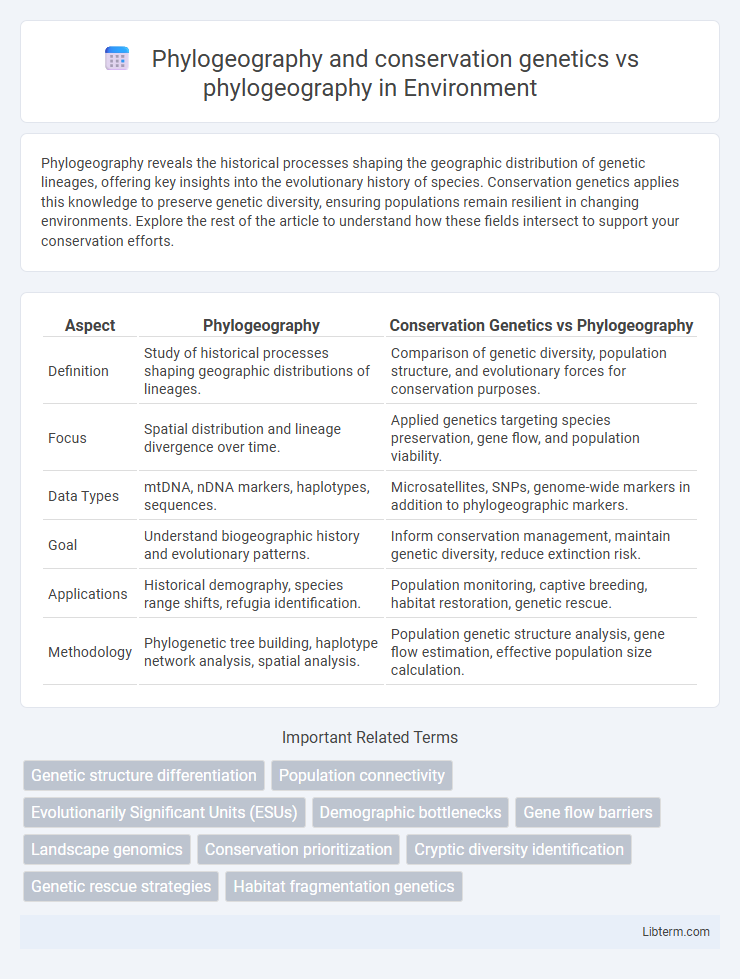Phylogeography reveals the historical processes shaping the geographic distribution of genetic lineages, offering key insights into the evolutionary history of species. Conservation genetics applies this knowledge to preserve genetic diversity, ensuring populations remain resilient in changing environments. Explore the rest of the article to understand how these fields intersect to support your conservation efforts.
Table of Comparison
| Aspect | Phylogeography | Conservation Genetics vs Phylogeography |
|---|---|---|
| Definition | Study of historical processes shaping geographic distributions of lineages. | Comparison of genetic diversity, population structure, and evolutionary forces for conservation purposes. |
| Focus | Spatial distribution and lineage divergence over time. | Applied genetics targeting species preservation, gene flow, and population viability. |
| Data Types | mtDNA, nDNA markers, haplotypes, sequences. | Microsatellites, SNPs, genome-wide markers in addition to phylogeographic markers. |
| Goal | Understand biogeographic history and evolutionary patterns. | Inform conservation management, maintain genetic diversity, reduce extinction risk. |
| Applications | Historical demography, species range shifts, refugia identification. | Population monitoring, captive breeding, habitat restoration, genetic rescue. |
| Methodology | Phylogenetic tree building, haplotype network analysis, spatial analysis. | Population genetic structure analysis, gene flow estimation, effective population size calculation. |
Understanding Phylogeography: Concepts and Applications
Phylogeography integrates genetic data with geographical distribution to unravel historical population structures and evolutionary processes, offering insights crucial for biodiversity conservation. Conservation genetics leverages phylogeographic findings to identify distinct population units and evolutionary significant units (ESUs) that require targeted management and protection. Understanding phylogeography facilitates the identification of genetic diversity patterns, enabling informed conservation strategies that preserve adaptive potential and reduce extinction risks.
Defining Conservation Genetics in Modern Research
Conservation genetics integrates phylogeography to assess genetic diversity and population structure for preserving species in fragmented habitats. Modern research emphasizes identifying evolutionary significant units (ESUs) through phylogeographic patterns to inform conservation strategies tailored to maintain adaptive potential. This approach enhances the accuracy of management plans by combining spatial genetic data with ecological factors.
Key Differences Between Phylogeography and Conservation Genetics
Phylogeography analyzes the historical processes shaping the geographic distribution of genetic lineages, emphasizing the spatial patterns of genetic variation driven by factors like glaciation and migration. Conservation genetics focuses on preserving genetic diversity within populations to enhance species survival and adaptability, addressing issues like inbreeding and genetic bottlenecks. Key differences include phylogeography's emphasis on evolutionary history and biogeography, while conservation genetics prioritizes applied management strategies targeting genetic health and population viability.
Historical Development of Phylogeography
Phylogeography originated in the 1980s as a discipline integrating phylogenetics and biogeography to examine historical population processes using genetic data. Conservation genetics expanded this framework by applying phylogeographic methods to identify Evolutionarily Significant Units (ESUs) for biodiversity conservation. The historical development of phylogeography emphasized the spatial distribution of genealogical lineages, which formed the basis for modern conservation strategies targeting genetic diversity and population structure.
Integrative Approaches: Bridging Phylogeography and Conservation Genetics
Integrative approaches combining phylogeography and conservation genetics enable a comprehensive understanding of species' evolutionary history and genetic diversity critical for effective conservation efforts. These methods use genetic markers, spatial distribution, and ecological data to identify distinct populations, evolutionary significant units (ESUs), and biodiversity hotspots for targeted management. Bridging phylogeography and conservation genetics enhances the precision of identifying genetic structure, gene flow, and adaptive potential essential for maintaining species resilience in changing environments.
Genetic Markers and Their Roles in Conservation Strategies
Genetic markers such as mitochondrial DNA, microsatellites, and single nucleotide polymorphisms (SNPs) play critical roles in both phylogeography and conservation genetics by revealing population structure, gene flow, and evolutionary history. In conservation strategies, these markers help identify distinct genetic units for targeted management, assess genetic diversity to prevent inbreeding, and guide habitat restoration efforts. Phylogeography utilizes these markers primarily to trace the geographic distribution of lineages, while conservation genetics applies them directly to preserving species' adaptive potential and resilience.
Case Studies: Phylogeographic Methods in Species Conservation
Case studies in phylogeographic methods highlight the integration of genetic data to delineate conservation units and identify evolutionary significant populations, enhancing species management strategies. Phylogeography combined with conservation genetics reveals historical population dynamics and adaptive variation, guiding targeted conservation efforts in fragmented habitats. These approaches provide crucial insights into genetic diversity, gene flow barriers, and demographic history essential for designing effective conservation policies.
Impacts of Gene Flow and Population Structure on Conservation
Phylogeography integrates genetic data with geographic distribution to reveal population structure and historical gene flow patterns crucial for conservation genetics. Gene flow influences genetic diversity and connectivity among populations, affecting their adaptability and resilience to environmental changes. Understanding population structure aids in identifying distinct management units, optimizing conservation strategies to maintain evolutionary potential and prevent inbreeding depression.
Future Perspectives in Phylogeography and Conservation Genetics
Future perspectives in phylogeography and conservation genetics emphasize integrating high-resolution genomic data with spatial ecology to better understand species' evolutionary histories and population structures. Advances in environmental DNA (eDNA) techniques and machine learning algorithms enable precise mapping of genetic diversity and gene flow patterns, aiding targeted conservation strategies. Embracing interdisciplinary approaches will enhance predictive models for species resilience under climate change, ensuring more effective biodiversity management.
Challenges and Opportunities in Genetic Conservation Planning
Phylogeography integrates genetic data with geographical distribution to reveal historical population structures, crucial for identifying evolutionarily significant units in conservation genetics. Genetic conservation planning faces challenges such as limited genetic sampling, incomplete lineage sorting, and gene flow obscuring phylogeographic patterns, complicating accurate delineation of conservation units. Opportunities arise from advancements in genome sequencing technologies and spatial modeling, enabling more precise assessments of genetic diversity and connectivity to inform targeted conservation strategies.
Phylogeography and conservation genetics Infographic

 libterm.com
libterm.com